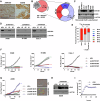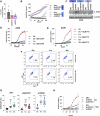Polyol pathway-generated fructose is indispensable for growth and survival of non-small cell lung cancer
- PMID: 39567724
- PMCID: PMC11982217
- DOI: 10.1038/s41418-024-01415-1
Polyol pathway-generated fructose is indispensable for growth and survival of non-small cell lung cancer
Abstract
Despite recent treatment advances, non-small cell lung cancer (NSCLC) remains one of the leading causes of cancer-related deaths worldwide, and therefore it necessitates the exploration of new therapy options. One commonly shared feature of malignant cells is their ability to hijack metabolic pathways to confer survival or proliferation. In this study, we highlight the importance of the polyol pathway (PP) in NSCLC metabolism. This pathway is solely responsible for metabolizing glucose to fructose based on the enzymatic activity of aldose reductase (AKR1B1) and sorbitol dehydrogenase (SORD). Via genetic and pharmacological manipulations, we reveal that PP activity is indispensable for NSCLC growth and survival in vitro and in murine xenograft models. Mechanistically, PP deficiency provokes multifactorial deficits, ranging from energetic breakdown and DNA damage, that ultimately trigger the induction of apoptosis. At the molecular level, this process is driven by pro-apoptotic JNK signaling and concomitant upregulation of the transcription factors c-Jun and ATF3. Moreover, we show that fructose, the PP end-product, as well as other non-glycolytic hexoses confer survival to cancer cells and resistance against chemotherapy via sustained NF-κB activity as well as an oxidative switch in metabolism. Given the detrimental consequence of PP gene targeting on growth and survival, we propose PP pathway interference as a viable therapeutic approach against NSCLC.
© 2024. The Author(s).
Conflict of interest statement
Competing interests: OS is the co-founder and manager of OncoCube Therapeutics LLC, founder, and president of LoxiGen, and the member of scientific advisory board of A2A Pharmaceuticals Inc. The other authors declare no conflict of interests.
Figures





References
-
- Hanahan D. Hallmarks of cancer: new dimensions. Cancer Discov. 2022;12:31–46. - PubMed
-
- Ramesh V, Brabletz T, Ceppi P. Targeting EMT in cancer with repurposed metabolic inhibitors. Trends Cancer. 2020;6:942–50. - PubMed
-
- Thiery JP, Acloque H, Huang RYJ, Nieto MA. Epithelial-mesenchymal transitions in development and disease. Cell. 2009;139:871–90. - PubMed
-
- Schwab A, Siddiqui A, Vazakidou ME, Napoli F, Böttcher M, Menchicchi B, et al. Polyol pathway links glucose metabolism to the aggressiveness of cancer cells. Cancer Res. 2018;78:1604–18. - PubMed
-
- Hers HG. The mechanism of the transformation of glucose in fructose in the seminal vesicles. Biochim Biophys Acta. 1956;22:202–3. - PubMed
MeSH terms
Substances
Grants and funding
- W81XWH-17-0404/U.S. Department of Defense (United States Department of Defense)
- 0066909/Novo Nordisk Fonden (Novo Nordisk Foundation)
- R01 CA249210/CA/NCI NIH HHS/United States
- R01CA249210/U.S. Department of Health & Human Services | NIH | National Cancer Institute (NCI)
- 70112536/Deutsche Krebshilfe (German Cancer Aid)
LinkOut - more resources
Full Text Sources
Medical
Research Materials
Miscellaneous

